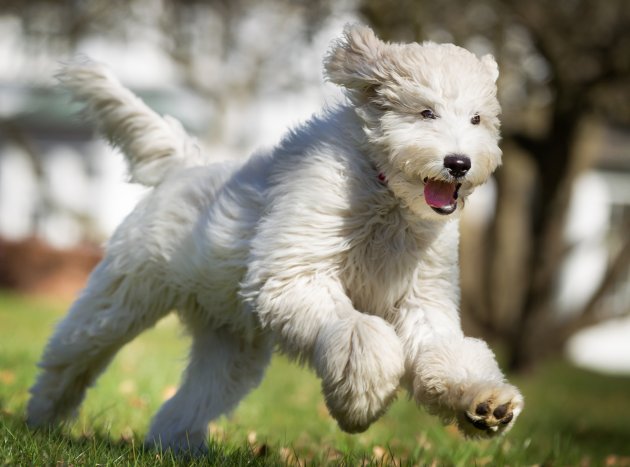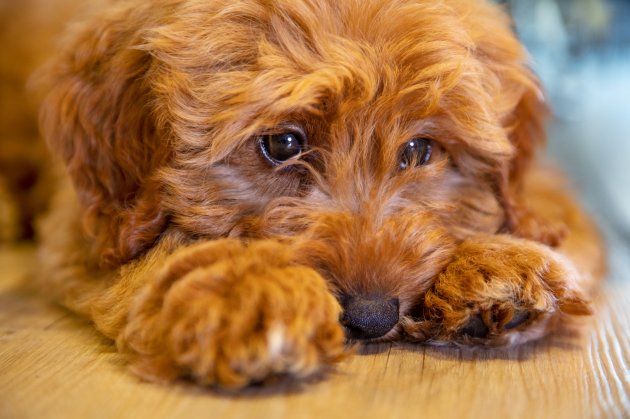An Australian Labradoodle and a Labradoodle are as different as chalk and cheese. The Australian Labradoodle has several ancestors, unlike the Labradoodle who is exclusively a cross between a Labrador Retriever and a Poodle. But what makes the Aussie Labradoodle even more interesting is the fact that he does not even have any Australian breed in him.
It all started when a blind woman from Hawaii requested Wally Conron, the breeding manager of the Royal Guide Dog Association in Australia, for an assistance dog that won’t trigger her husband’s allergies. After countless attempts, Conron finally opened Pandora’s Box in 1988 where the Australian Labradoodle made history.
The Australian Labradoodle carries the lineage of the Labrador Retriever, Poodle, American/English Cocker Spaniel, Irish Water Spaniel, and Wheaten Terrier. For a breed to be considered as an Australian Labradoodle, it must include a combination of the first three breeds.

Although the Australian Labradoodle may not have descended from any Aussie breed, he was the world’s first designer dog who sprang to life in Australia. Thus, the name. Yes, the Australian Labradoodle started the wave of Corgskis , Chowskies, Maltipoos, Puggles, and perhaps… the Doberhuahua?
Read on and learn surprising facts about this exquisite breed!
What Does an Australian Labradoodle Look Like?
Australian Labradoodles are graceful galloping dogs who give the appearance that they are always “going somewhere.” Now, let’s have a closer look at their unique features.
Face
The Australian Labradoodle has a broad chiseled head and a square muzzle. He has a pair of big, round, expressive eyes underneath well-defined eyebrows. Aussie Labradoodles have either black or rose pigmentation on the nose, lips, and pads. Their medium-thick floppy ears are set flat against their head at eye level.
Body
The Aussie Labradoodle has a square athletic body frame that still appears compact. Since he is a galloping dog, he has well-sprung ribs and a flank that rises from a deep brisket. Likewise, he has firm elbows and short strong hocks that provide him with good reach and drive when moving.
Coat and Color
The Australian Labradoodle has a single-coat that varies in three types:
Hair
An Aussie Labradoodle sporting a hair coat has a bearded face and sparse feathering on his legs. Sometimes, he may also have a shaggy look. Hair coats shed in different degrees, requiring high maintenance. Hence, it is easily the least desirable coat among the three.
Fleece
Fleece is a non-shedding coat and can have a straight, wavy, or soft spiral look to it. This type of coat is highly coveted in Australian Labradoodles not only because it is manageable, but it is also hypoallergenic, and it feels as soft and silky as mohair.
Wool
Similar to a lamb’s wool, this type of coat has a lightweight, silky-smooth texture. It is a non-shedding coat and can have tight curls or loose spirals. An Aussie Labradoodle sporting a wool coat may also have a thick and very dense straight look, instead. However, this type of look demands the highest maintenance.
Moreover, the Australian Labradoodle is bred to 10 different colors: apricot, black, blue, café, chalk, chocolate, cream, gold, red, and silver. This breed is always solid in color. White markings are considered a fault, but patches no larger than 2.5 cm on the chest, foot, or tail is acceptable.
Size and Weight
The Australian Labradoodle is bred to three different sizes:
Miniature
A mini Australian Labradoodle ranges between 13 to 17 inches and weighs between 10 kilograms to 20 kilograms.
Medium
A medium-sized Australian Labradoodle is just a tad bigger than the miniature variety. It measures between 18 to 21 inches in height and 15 kilograms to 25 kilograms in weight.
Standard
A standard Australian Labradoodle can reach a full height of 26 inches and weigh up to 40 kilograms.
Temperament
Aussie Labradoodles can be described as cheerful and curious pooches that are ever ready for adventures. They are suitable for novice owners, multi-pet households, and children. Likewise, they adapt well to apartment living, but they thrive best in a home with a yard.
Their witty waggish ways make them amusing companions, while their striking intelligence and intuitiveness make them exceptional service dogs.
But because they are too friendly with animals and strangers, it is unlikely that your pooch will ward off garden-variety thieves.
Health Concerns
Health problems may arise in Australian Labradoodles, as with a majority of canine hybrids.
Allergies
It is common for Aussie Labradoodles to experience allergies from the food they eat, such as grains and poultry. Usually, food allergies lead to skin irritation or an upset stomach.
Ear Infection
The ears of the Australian Labradoodle need special attention, as they are close to the side of his head. This means it easily gets warm and moist, creating a rich environment for bacteria to thrive in.
Adding to that, the beautiful glossy locks of an Aussie Labradoodle may also grow inside his ear canals. Without proper care, the hair will continue to grow and become a dirt magnet.
Hip and Elbow Dysplasia
Hip and elbow dysplasia is a possibility, but only a few will develop this condition. As mentioned earlier, Australian Labradoodles are light on their feet, as they go about prancing and skimming instead of lumbering like most heavy breeds. Likewise, they have a light frame and a compact body and thus, the chance of a dysplasia problem is put to a minimum.
Retinal Atrophy
The Australian Labradoodle might inherit some medical concerns that most commonly affect its parent breeds, such as retinal atrophy. It is an eye disease that causes progressive vision loss. Sadly, treatment for this disease is yet to be found.
Lifespan
A happy and healthy Australian Labradoodle can give 13 to 15 years of sunshine to your life.

Maintenance
Food
Since Aussie Labradoodles are prone to allergies, dog food made with natural and limited whole ingredients make the best option. If your pooch has gluten-sensitivity, choose a grain-free dog food. Salmon, lamb, and beef make good primary sources of protein for allergic dogs. Be careful with plant-based proteins. Some dogs don’t digest legumes well.
Some pet parents may prefer to feed their fur-kids a raw diet because it lacks preservatives and other unnecessary ingredients that most commercial dog foods have. However, you need to consult your vet for a professional opinion before you embark on such a feeding regimen. Take note that your dog requires different nutritional formulas as he ages.
Exercise
Australian Labradoodles enjoy being out and about. Although they are not high-energy dogs, they do need short walks daily to keep themselves happy and fit as a fiddle. While indoors, give your pet a range of mentally stimulating toys to ease boredom.
Grooming
Hair Plucking
You must make regular visits to the groomer or have your vet pluck the extra hair in your dog’s ear canal. Otherwise, the extra hair will continue to grow and block the airflow into your dog’s ears. Remember, air circulation is crucial to healthy ears! You may also do this task at home, but be sure not to let things out of control. The task can be simple and straightforward as long as you have the right tools and products.
Apply an ear grooming powder in the middle of your pooch’s ear and massage the powder for 20 seconds. Doing so will open up the pores and dries up your dog’s ears so you can get a firm grip on each hair strand. You should be able to see the ear canal.
Your dog may not like it at first, but he will soon get used to it. Don’t give in to your dog’s yapping. You must persevere if he squirms and complains. It is much better to go through this uncomfortable activity rather than have your pooch develop an ear infection.
Eventually, your Aussie Labradoodles will learn to become compliant, as he will begin to understand that grooming his ears will make him feel much better afterwards.
Ear Cleaning
Keep your dog’s floppy ears fresh and clean by using a good ear cleaner. This will eliminate excess wax and dirt buildup. All you have to do is pour a few drops of ear cleaning solution in each ear canal and massage it for about 15 to 20 seconds.
Bathing and Brushing
The Aussie Labradoodle’s non-shedding coat has naturally occurring essential oils that make it look sleek and neat. Hence, you don’t want to strip off these oils by bathing your pooch too often.
However, they do need frequent brushing. Otherwise, your dog’s coat will felt and this will only be corrected by clipping right down to his skin. Aussie Labradoodles need 30 to 45 minutes of brushing at least twice each week. For a more effective brushing, you need a slicker brush and a metal comb.
Clipping
Arrange for a trip to the groomer once your puppy reaches seven months. Tell your groomer to aim for the “Teddy Bear” look, not the “perfect and preened” look that groomers give to poodles – unless you want that. A trip to the groomer four times per year is something to aim for if you have an Aussie Labradoodle.
A Reminder from Wally Conran
Wally Conron has emphasized the importance of getting a puppy from ethical breeders. There is an enormous possibility that Australian Labradoodles from backyard breeders may not be trainable or hypoallergenic, which beats the purpose of getting one in the first place. Worst-case scenario, you may not even get a real Australian Labradoodle. Therefore, you must do a background check and ask for a certificate.
Takeaway
The Australian Labradoodle may be the trailblazer of designer breeds, but the American Kennel Club recognized it as a hybrid breed rather than a separate pedigree breed. However, this breed is recognized by the International Australian Labradoodle Association, Inc., the Labradoodle Association of Australia, and the Dog Registry of America.
References and further readings:
- Kenworthy, Alan. (2015) Labradoodle: The Owner’s Guide from Puppy to Old Age for Your American, British, or Australian Labradoodle. Feel Happy Limited.
- https://alaa-labradoodles.com
- https://www.psychologytoday.com/us/blog/canine-corner/201404/designer-dog-maker-regrets-his-creation